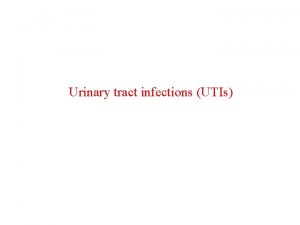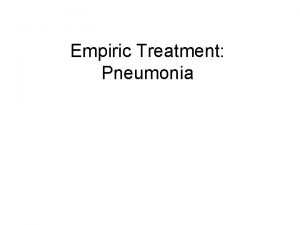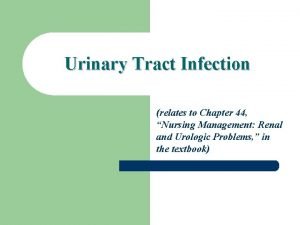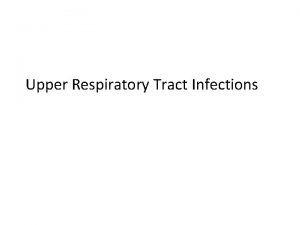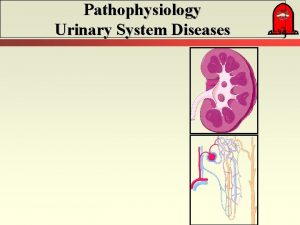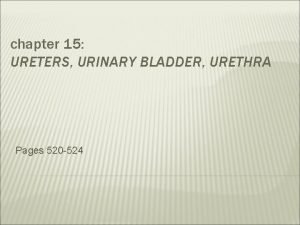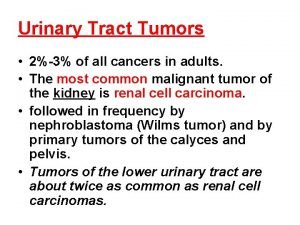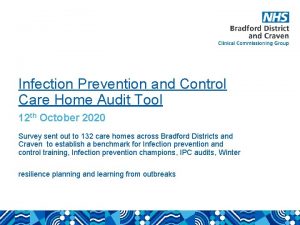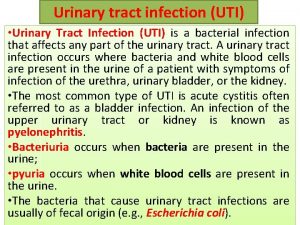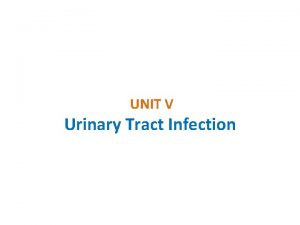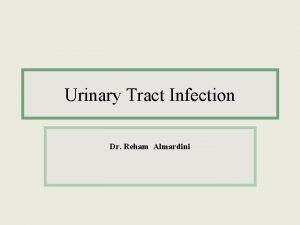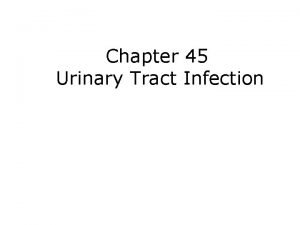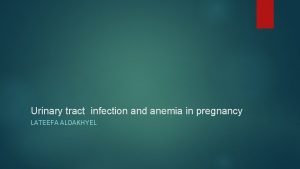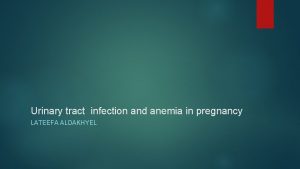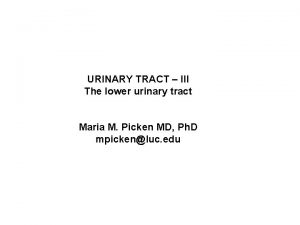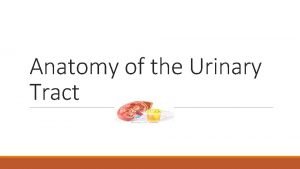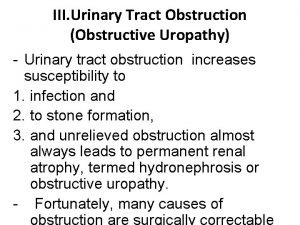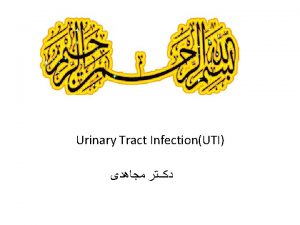URINARY TRACT INFECTION IN PREGNANCY A urinary tract
















- Slides: 16

URINARY TRACT INFECTION IN PREGNANCY

• A urinary tract infection (UTI) is an infection that begins in the urinary system. • UTIs limited to the bladder can be painful and annoying.


Parts of the urinary tract • two kidneys - a pair of purplish-brown organs located below the ribs toward the middle of the back. • two ureters - narrow tubes that carry urine from the kidneys to the bladder. • bladder - a triangle-shaped, hollow organ located in the lower abdomen. • two sphincter muscles - circular muscles that help keep urine from leaking by closing tightly like a rubber band around the opening of the bladder. • urethra -the tube that allows urine to pass outside the body.


Pregnancy and urinary tract infections: CHANGES IN THE URINARY SYSTEM DURING PREGNANCY Ø Kidney enlargement Ø Compression of the ureters and bladder Ø Incomplete emptying of the bladder Ø The urine is not as acidic Ø It contains more sugars, protein, and hormones.

Types of UTI in pregnancy q ASYMPTOMATIC BACTERIURIA • silent (without symptoms) infection • caused by bacteria present in the woman's system before pregnancy • may lead to pyelonephritis if left untreated. q ACUTE URETHRITIS OR CYSTITIS • symptoms including pain or burning with urination, frequent urination, feeling of needing to urinate, and fever. q PYELONEPHRITIS • a kidney infection • symptoms of acute cystitis plus flank (back) pain • may lead to preterm labor, severe infection, and adult respiratory distress syndrome.

The most common causative organism of UTI • Escherichia coli (E. coli) Other organisms may also cause UTI • group B streptococcus, and sexually transmitted gonorrhea and chlamydia.

Signs and symptoms • A strong, persistent urge to urinate • A burning sensation when urinating • Passing frequent, small amounts of urine • Blood in the urine (hematuria) or cloudy, strong-smelling urine

Diagnosis: Dip slide technique Treatment: For 7 to 10 days 1. Ampillicin 500 mg qid 2. Nitrofurantoin 100 mg qid 3. Cephalexin 500 mg tid 4. Amoxicillin – Clavulanic acid 375 mg tid In case of recurrent infection, Nitrofurantoin 50 mg or Amoxycillin 250 mg at night to continue till delivery

Cystitis ù Results from bacterial infections of the bladder ù Often in the 16 th week of pregnancy with marked retroversion of the gravid uterus ù Urine examination reveals: RBC, pus cells and bacteria ù Treatment: antimicrobial therapy and correction of retoversion.

Pyelonephrititis ³Condition characterized by an inflammation of the renal parenchyma and collecting tubules ³Predisposing factors: ØProgesterone ØPressure by the gravid uterus

³Clinical features üSymptomatic manifestations like fever, malaise, nausea, vomiting and urgency of micturition and tenderness at renal angle of the affected side. ³Investigations üHb, TC and DC, C – reactive protein üBlood culture üUrine: smear, culture and antibiotic sensitivity üRenal function test

³Management • Admission to hospital • Complete bed rest • Intravenous fliuds • Intravenous antibiotics • Antipyretics • Continuation of treatment with oral antibiotics for at least 2 weeks

³Complications • Septicemia • ARDS • Renal abscess and scarring • Preterm labour and delivery • Increased perinatal morbidity and mortality • DIC

Prevention of UTI • Drink plenty of liquids • Urinate promptly • Wipe from front to back • Empty your bladder as soon as possible after intercourse. Also, drink a full glass of water to help flush bacteria. • Avoid potentially irritating feminine products
 Urinary tract infection in pregnancy ppt
Urinary tract infection in pregnancy ppt ç
ç Complicated urinary tract infection
Complicated urinary tract infection Urised otc
Urised otc Bladder infection symptoms
Bladder infection symptoms Molar pregnancy symptoms
Molar pregnancy symptoms Nursing management of reproductive tract infection
Nursing management of reproductive tract infection Classification of upper respiratory tract infection
Classification of upper respiratory tract infection Conclusion of respiratory tract infection
Conclusion of respiratory tract infection Urinary tract obstruction
Urinary tract obstruction Urinary bladder
Urinary bladder Tumor in the urinary tract
Tumor in the urinary tract Extrapyramidal tract names
Extrapyramidal tract names Rubrospinal tract
Rubrospinal tract Infection controlcare home
Infection controlcare home Mobilivirus
Mobilivirus Fungi
Fungi
